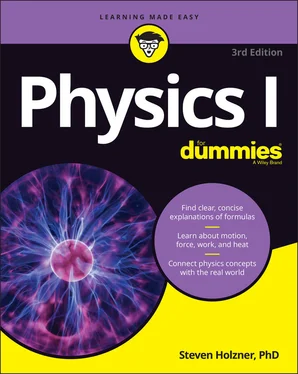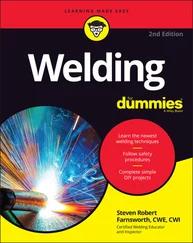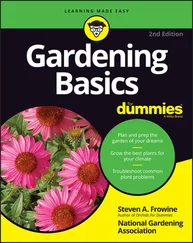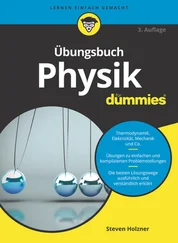Steven Holzner - Physics I For Dummies
Здесь есть возможность читать онлайн «Steven Holzner - Physics I For Dummies» — ознакомительный отрывок электронной книги совершенно бесплатно, а после прочтения отрывка купить полную версию. В некоторых случаях можно слушать аудио, скачать через торрент в формате fb2 и присутствует краткое содержание. Жанр: unrecognised, на английском языке. Описание произведения, (предисловие) а так же отзывы посетителей доступны на портале библиотеки ЛибКат.
- Название:Physics I For Dummies
- Автор:
- Жанр:
- Год:неизвестен
- ISBN:нет данных
- Рейтинг книги:3 / 5. Голосов: 1
-
Избранное:Добавить в избранное
- Отзывы:
-
Ваша оценка:
- 60
- 1
- 2
- 3
- 4
- 5
Physics I For Dummies: краткое содержание, описание и аннотация
Предлагаем к чтению аннотацию, описание, краткое содержание или предисловие (зависит от того, что написал сам автор книги «Physics I For Dummies»). Если вы не нашли необходимую информацию о книге — напишите в комментариях, мы постараемся отыскать её.
Physics I For Dummies
Physics I For Dummies
Physics I For Dummies — читать онлайн ознакомительный отрывок
Ниже представлен текст книги, разбитый по страницам. Система сохранения места последней прочитанной страницы, позволяет с удобством читать онлайн бесплатно книгу «Physics I For Dummies», без необходимости каждый раз заново искать на чём Вы остановились. Поставьте закладку, и сможете в любой момент перейти на страницу, на которой закончили чтение.
Интервал:
Закладка:
| Unit Prefix | Exponent |
|---|---|
| mega (M) | 10 6 |
| kilo (k) | 10 3 |
| centi (c) | 10 –2 |
| milli (m) | 10 –3 |
micro (  ) ) |
10 –6 |
| nano (n) | 10 –9 |
| pico (p) | 10 –12 |
Checking the Accuracy and Precision of Measurements
Accuracy and precision are important when making (and analyzing) measurements in physics. You can’t imply that your measurement is more precise than you know it to be by adding too many significant digits, and you have to account for the possibility of error in your measurement system by adding a  when necessary. This section delves deeper into the topics of significant digits, precision, and accuracy.
when necessary. This section delves deeper into the topics of significant digits, precision, and accuracy.
Knowing which digits are significant
This section is all about how to properly account for the known precision of the measurements and carry that through the calculations, how to represent numbers in a way that is consistent with their known precision, and what to do with calculations that involve measurements with different levels of precision.
Finding the number of significant digits
In a measurement, significant digits (or significant figures ) are those that were actually measured. Say you measure a distance with your ruler, which has millimeter markings. You can get a measurement of 10.42 centimeters, which has four significant digits (you estimate the distance between markings to get the last digit). But if you have a very precise micrometer gauge, then you can measure the distance to within one-hundredth of that, so you may measure the same thing to be 10.4213 centimeters, which has six significant digits.
By convention, zeroes that simply fill out values down to (or up to) the decimal point aren’t considered significant. When you see a number given as 3,600, you know that the 3 and 6 are included because they’re significant. However, knowing which, if any, of the zeros are significant can be tricky.
 The best way to write a number so that you leave no doubt about how many significant digits there are is to use scientific notation. For example, if you read a measurement of 1,000 meters, you don’t know if there are one, two, three, or four significant figures. But if it were written as
The best way to write a number so that you leave no doubt about how many significant digits there are is to use scientific notation. For example, if you read a measurement of 1,000 meters, you don’t know if there are one, two, three, or four significant figures. But if it were written as  meters, you would know that there are two significant figures. If the measurement were written as
meters, you would know that there are two significant figures. If the measurement were written as  meters, then you would know that there are four significant figures.
meters, then you would know that there are four significant figures.
Rounding answers to the correct number of digits
When you do calculations, you often need to round your answer to the correct number of significant digits. If you include any more digits, you claim a precision that you don’t really have and haven’t measured.
For example, if someone tells you that a rocket traveled 10.0 meters in 7.0 seconds, the person is telling you that the distance is known to three significant digits and the seconds are known to two significant digits (the number of digits in each of the measurements). If you want to find the rocket’s speed, you can whip out a calculator and divide 10.0 meters by 7.0 seconds to come up with 1.428571429 meters per second, which looks like a very precise measurement indeed. But the result is too precise — if you know your measurements to only two or three significant digits, you can’t say you know the answer to ten significant digits. Claiming as such would be like taking a meter stick, reading down to the nearest millimeter, and then writing down an answer to the nearest ten-millionth of a millimeter. You need to round your answer.
 The rules for determining the correct number of significant digits after doing calculations are as follows:
The rules for determining the correct number of significant digits after doing calculations are as follows:
When you multiply or divide numbers: The result has the same number of significant digits as the original number that has the fewest significant digits. In the case of the rocket, where you need to divide, the result should have only two significant digits (the number of significant digits in 7.0). The best you can say is that the rocket is traveling at 1.4 meters per second, which is 1.428571429 rounded to one decimal place.
When you add or subtract numbers: Line up the decimal points; the last significant digit in the result corresponds to the right-hand column where all numbers still have significant digits. If you have to add 3.6, 14, and 6.33, you’d write the answer to the nearest whole number — the 14 has no significant digits after the decimal place, so the answer shouldn’t, either. You can see what we mean by taking a look for yourself:

When you round the answer to the correct number of significant digits, your answer is 24.
 When you round a number, look at the digit to the right of the place you’re rounding to. If that right-hand digit is 5 or greater, round up. If it’s 4 or less, round down. For example, you round 1.428 up to 1.43 and 1.42 down to 1.4.
When you round a number, look at the digit to the right of the place you’re rounding to. If that right-hand digit is 5 or greater, round up. If it’s 4 or less, round down. For example, you round 1.428 up to 1.43 and 1.42 down to 1.4.
Estimating accuracy
Physicists don’t always rely on significant digits when recording measurements. Sometimes, you see measurements that use plus-or-minus signs to indicate possible error in measurement, as in the following:

The  part (0.05 meters in the preceding example) is the physicist’s estimate of the possible error in the measurement, so the physicist is saying that the actual value is between
part (0.05 meters in the preceding example) is the physicist’s estimate of the possible error in the measurement, so the physicist is saying that the actual value is between  (that is, 5.41) meters and
(that is, 5.41) meters and  (that is, 5.31 meters), inclusive. Note that the possible error isn’t the amount your measurement differs from the “right” answer; it’s an indication of how precisely your apparatus can measure — in other words, how reliable your results are as a measurement.
(that is, 5.31 meters), inclusive. Note that the possible error isn’t the amount your measurement differs from the “right” answer; it’s an indication of how precisely your apparatus can measure — in other words, how reliable your results are as a measurement.
Arming Yourself with Basic Algebra
Physics deals with plenty of equations, and to be able to handle them, you should know how to move the variables in them around. Note that algebra doesn’t just allow you to plug in numbers and find values of different variables; it also lets you rearrange equations so you can make substitutions in other equations, and these new equations show different physics concepts. If you can follow along with the derivation of a formula in a physics book, you can get a better understanding of why the world works the way it does. That’s pretty important stuff! Time to travel back to basic algebra for a quick refresher.
Читать дальшеИнтервал:
Закладка:
Похожие книги на «Physics I For Dummies»
Представляем Вашему вниманию похожие книги на «Physics I For Dummies» списком для выбора. Мы отобрали схожую по названию и смыслу литературу в надежде предоставить читателям больше вариантов отыскать новые, интересные, ещё непрочитанные произведения.
Обсуждение, отзывы о книге «Physics I For Dummies» и просто собственные мнения читателей. Оставьте ваши комментарии, напишите, что Вы думаете о произведении, его смысле или главных героях. Укажите что конкретно понравилось, а что нет, и почему Вы так считаете.












